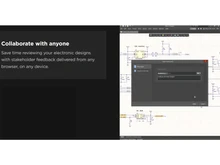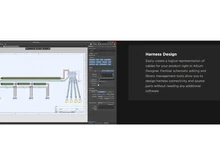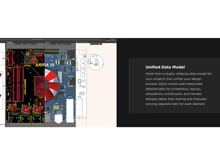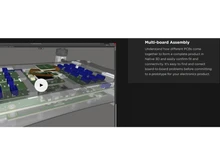It can be quite challenging to select the best PCB design software given the number of options available. Two such popular software for layout & schematic capture are Altium & KiCad. Although these two solutions are significantly different from one another, they share many fundamental characteristics. We have included a thorough comparison of KiCad vs. Altium to help you grasp the key features and variations.
Both KiCad and Altium have been on the market for more than ten years, and as a result, they have undergone upgrades and modifications based on user reviews.
KiCad vs Altium: An Overview
One of the most exciting Electronic Design Automation (EDA) solutions is KiCad. It is a free and open-source software platform with excellent functionalities. It provides tools for developing PCBs, circuit layouts, and schematics. Additionally, it offers several sophisticated features for BOM (Bill of Material) generation, artwork creation, rendering, and 3D modeling. The fact that KiCad supports multiple platforms is yet another amazing feature. It is free to download and install on macOS, Windows, and Linux.
However, Altium is a pioneer in the field of PCB design sector. This program's simple interface and cutting-edge technological proficiency add to its popularity. The ease of use makes it possible even for inexperienced designers to work and design projects. It also offers high-end functionalities to advanced and experienced users.
Altium offers a wide range of features for rendering and 3D viewing, has an adaptable UI along with content libraries, broad format support, etc. Apart from that, some of the additional benefits for Altium users include cloud services, automatic routing, filtering, tuning, and more that help create high-speed designs.
KiCad and Altium: Pros & Cons
- The primary distinction between the two is that KiCad is completely free, whereas Altium licenses require payment.
- Altium can only be used with systems operating on Windows x64, but KiCad can function on the majority of popular operating systems present on both Windows x64 and Windows x32 devices.
- KiCad offers 3D viewing, whereas Altium offers better MCAD interoperability and rendering, combining ECAD with other mechanical designs.
- Altium provides a wide range of production related & DFM functionalities that KiCad does not.
- The customized user interface of Altium helps professionals complete their work quickly without spending much time on navigating. Although KiCad offers shortcuts, its user interface cannot be customized.
KiCad vs Altium: In Terms of Features
Altium offers some advanced features like auto-routing, a communication hub for updates/notifications, multi-sheet schematics, high-speed features, and centralized library content. However, these features are missing in KiCad.
- Auto-Routing: KiCad lacks the extremely powerful auto-routing features offered by Altium. This feature includes interactive aspects that guarantee optimal routing of designs.
- Notifications/Updates: For those who operate remotely, Altium includes a hub for communication that facilitates both chats and file exchange, as well as a centre for work updates. However, these features are unavailable in KiCad.
- Multi-Sheet Schematics: Altium includes capabilities for handling difficult projects and offers multi-sheet schematics. However, KiCad doesn’t as it is primarily geared toward beginners.
- High-Speed: Altium has capabilities for handling complicated projects with high-speed functionality along with hi-tech options for tuning and filtering. However, these features are not supported by KiCad.
- Library Content: The library of any PCB design includes footprints, symbols, 3D models, etc. for different electronic components. Altium’s library content is entirely centralized and provides a wide variety of conveniently accessible content. The libraries of KiCad, on the other hand, require enhancement and centralization.
Comparison of KiCad vs Altium in Terms of Pricing
Altium provides a 15-day free trial that gives users access to all its features, including interactive routing, design syncing, BOM creation, sharing, and project history viewing. Additionally, qualifying institutions and students can download its Academic trial versions for free for a period of six months upon registration.
Altium offers three different paid plans to their users, including Standard, Pro, and Enterprise designed for designers, teams, and organizations respectively. KiCad, on the other hand, is entirely cost-free software that does not involve any download or maintenance costs. In fact, the upgrades are cost-free.
KiCad vs Altium: User Interface
The user-friendly interface of KiCad makes it simple for beginners to pick up designing and quickly advance their skills. However, it cannot be customized to suit the preferences of the users. On the other hand, the learning curve for Altium is steeper, which makes it less intuitive. Yet, it can be customized to your preferences due to Altium's wide range of library content.
In terms of the user interface, KiCad and some other KiCad alternatives are ahead of Altium as their UI is quite simple and even beginners can use them.
KiCad vs Altium: Target Users
Anyone interested in learning PCB designing or undertaking new projects can use KiCad for free. It can handle even complex designs and is simple to configure and use. On the other hand, Altium is perfect for any research-related projects in industries that have DFM or production needs. It is also useful for team projects that involve remote working, and people working on more advanced designs and projects.
KiCad or Altium: Supported Platforms
Altium is primarily supported on the Windows platform only. However, KiCad is compatible with Windows, Linux, Ubuntu, and macOS platforms. The complete specification with details is mentioned below.
- Standard Edition (2016) of Windows Server, 64-bit of R2 Edition-2012
- Windows 8 & 10 (64-bit)
- Windows 10, 8.1, 8, 7, and Server (2019, 2016, 2012) Editions
- macOS versions- 10.14, 10.13, and 10.12
- Linux/GNU: Ubuntu {16.04 - 20.04} (LTS)
- Debian 9 & 10
- Fedora 29 to 32
KiCad vs Altium: Technical Specifications/System Requirements
Altium’s system requirements are far better than KiCad as it offers advanced screen resolution, better storage space, RAM, and more. Other Altium alternatives also offer similar system requirements. The detailed system requirements for KiCad and Altium are mentioned below:
- KiCad System Requirements:
- Supported Processor: 32-bit or 64-bit (Intel, ARM, PowerPC) and 64-bit MIPS.
- RAM - 1GB (recommendation - 2GB)
- Hard Drive Space – max of 10GB available
- Screen Resolution: 1280×1024 (recommendation: 1920×1080 & more)
- Graphics Card: Having OpenGL 2.1 and more to support hardware shaders
- Altium System Requirements:
- Supported Processor: Intel Core version i5 and equivalent
- Screen Resolution: 1600×1200 & more
- RAM: 4GB
- Video Memory: 3GB DDR4 or DDR5
- Storage Space: 12GB
- Internet Connection: Minimum of 512Kbps
- For BOM: Microsoft Excel
- For DbLibs: Microsoft Access
Which Is Better KiCad or Altium?
Altium is the appropriate answer when discussing PCB design in particular. The combination of its powerful performance and cutting-edge features will enable you to work on any design. A vast and user-friendly knowledge library is also available, and its user interface can be tailored to your requirements.
KiCad, on the other hand, is an excellent option for consumers seeking a more affordable option. This suite provides all of the fundamental design features along with a few more features, making it the clear victor when taking into account the software's cross-platform flexibility. Apart from that, it offers a simple UI and a simple learning curve to its users.


 5 Ratings & 0 Reviews
5 Ratings & 0 Reviews






















